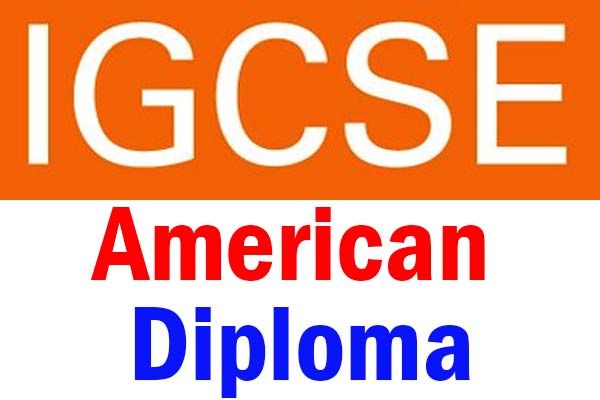IGCSE vs. American Diploma: Which One to Choose?
The IGCSE and American High School Diploma Exams are two different secondary education qualifications recognized globally.
The IGCSE is a general qualification that students worldwide take, while students in the United States take the American High School Diploma Exams.
The primary difference between the two exams is their intent. The IGCSE exam is structured to provide students with a general secondary education qualification, allowing them to be admitted to universities worldwide.
The American High School Diploma Exams aim to offer students a qualification that universities within the United States acknowledge.
The IGCSE and American High School Diploma Exams occur at separate instances and educational levels. The IGCSE is undertaken at the culmination of secondary education, while the American High School Diploma Exams transpire at the close of high school.
While both qualifications are recognized globally, they have different requirements and purposes. Students who intend to study in the United States may find the American High School Diploma Exams more suitable.
In contrast, students planning to study in other countries may find the IGCSE more suitable. Students must understand the differences between the two qualifications and choose the one best suited to their needs and goals.
Key Differences between IGCSE and American Diploma
Curriculum
The IGCSE is a globally acknowledged curriculum offering a comprehensive and well-rounded study of various subjects. Its primary objective is cultivating students’ problem-solving abilities, critical thinking, and creativity skills.
The IGCSE curriculum emphasizes practical and hands-on learning, developing students’ understanding of real-world issues.
The American Diploma curriculum is designed to provide students with a well-rounded education, equipping them for college and future endeavors.
🌟 Hey Students! 🚀 Ready for the ultimate experience? Join us on Studentsinside.com's Facebook, YouTube, WhatsApp, and LinkedIn. Click now for tips, fun, and success vibes! 🌈✨ #StudentLife #JoinUs
This curriculum revolves around fundamental subjects like English, mathematics, science, and social studies. Its primary goal is to establish a robust foundation in these disciplines and foster the development of critical thinking and analytical abilities in students.
Structure
The IGCSE program follows a two-year course structure, with students appearing for exams after each year. This program boasts flexibility, enabling students to select from an extensive array of subjects and customize their studies according to their unique interests and aptitudes.
The American Diploma program spans a four-year course duration, encompassing a variety of core subjects and electives. The primary aim of this program is to deliver a comprehensive education that readies students for college and future pursuits.
Subjects
The IGCSE program presents diverse subjects, encompassing mathematics, science, languages, humanities, and the arts. Its purpose is to deliver a comprehensive and well-rounded education, fostering skills development in multiple domains.
The American Diploma program features subjects such as English, mathematics, science, social studies, and elective courses. This program aims to give students an all-inclusive education, equipping them for success in college and beyond.
The IGCSE and American Diploma programs deliver exceptional educational experiences, preparing students for college and future endeavors.
Choosing between these programs depends on each student’s unique interests, aptitudes, and professional aspirations.
Age and Grade Levels
IGCSE
The IGCSE program is designed to provide a broad and balanced curriculum that develops students’ knowledge and skills in various subjects for students aged 14-16.
The IGCSE program offers a flexible curriculum that allows students to choose from multiple subjects, including languages, sciences, humanities, and vocational subjects.
The IGCSE program is recognized by universities and employers worldwide and is a valuable qualification for students who wish to continue their education or enter the workforce. The IGCSE program is divided into two levels: Core and Extended.
The Core level is designed for students expected to achieve grades C to G, while the Extended level is designed for students expected to achieve grades A* to C.
American Diploma
The American Diploma is a high school diploma awarded to students who complete their secondary education in the United States.
The American education system is divided into four levels: Elementary School (grades K-5), Middle School (grades 6-8), High School (grades 9-12), and College or University.
Students in the United States typically start high school at the age of 14 and graduate at the age of 18. High school is divided into four grades: 9th grade (freshman), 10th grade (sophomore), 11th grade (junior), and 12th grade (senior).
Students must fulfill a specific number of credits, which differ across states, to graduate.
The American education system provides multiple programs for students seeking higher education opportunities, including Advanced Placement (AP) courses, enabling students to gain college credit during high school, and the International Baccalaureate (IB) program is an internationally acknowledged qualification for students aged 16-19 years.
The IGCSE program is designed for students aged 14-16 years and offers a flexible curriculum that allows students to choose from various subjects. At the same time, the American education system is divided into four levels and offers multiple programs for students who wish to pursue higher education.

International Recognition
When it comes to choosing between an IGCSE and an American Diploma, one factor that is often considered is international recognition. This section will explore how universities and employers view these qualifications worldwide.
Universities
Cambridge qualifications, including the IGCSE, are recognized and valued by leading universities worldwide as evidence of academic ability.
According to Cambridge Assessment International Education, over 600 universities in the US recognize Cambridge International AS and A Level qualifications, with many offering advanced standing or credit to students who have achieved good grades.
Universities around the world generally accept American Diplomas. However, it is essential to be aware that the level of recognition for American Diplomas may differ based on the specific country and educational institution.
In the US, they are accepted by all accredited colleges and universities, and many universities in other countries also recognize them.
Employers
The IGCSE and American Diploma are recognized by employers worldwide as evidence of academic achievement. However, the level of recognition can vary depending on the industry and the employer.
According to Cambridge Assessment International Education, employers highly value Cambridge qualifications in the finance, engineering, and technology industries. Many multinational companies also recognize them as evidence of a candidate’s ability to work in a global environment.
Employers acknowledge American Diplomas across various sectors, such as finance, healthcare, and technology. These diplomas hold significant value for numerous multinational corporations, especially those with operations in the US.
Universities and employers across the globe acknowledge both the IGCSE and American Diploma. Nevertheless, the extent of recognition may differ based on the country, sector, and institution. When deciding between these credentials, students must consider their career objectives and the industries they wish to pursue.
Assessments and Exams
IGCSE
The IGCSE is a globally recognized qualification the Cambridge Assessment International Education Board provides.
The IGCSE curriculum aims to lay the groundwork for further education and encompasses many subjects, including languages, mathematics, sciences, and humanities.
IGCSE assessments utilize a grading scale from A* to G, with A* as the highest grade. These evaluations examine students’ comprehension of the subject matter and their capacity to apply this knowledge in real-life scenarios. The exams occur biannually, during May/June and October/November.
American Diploma
The American Diploma is a prestigious credential granted to students who have successfully finished their high school education in the United States. This diploma is acknowledged by educational institutions across the globe, making it a highly sought-after qualification for those aspiring to continue their academic journey in higher education.
The American Diploma is granted to students depending on their performance in various evaluations, such as standardized tests, coursework, and examinations. These assessments measure students’ comprehension of the subject matter and their capacity to employ that understanding in practical scenarios.
The most frequently administered standardized tests for the American Diploma are the SAT and ACT. These exams evaluate a student’s mathematics, reading, and writing proficiency. They are held multiple times annually, allowing students to retake them to enhance their scores.
The IGCSE and American Diploma are valuable qualifications that can open doors to higher education and employment opportunities. While the IGCSE focuses more on a global curriculum, the American Diploma is tailored to the American education system.
Comparison of IGCSE and American Diploma
When choosing between the International General Certificate of Secondary Education (IGCSE) and the American Diploma, it’s essential to understand the differences. Here’s a comparison of the two programs based on pass rates, grading system, and science and math subjects.
Pass Rates
According to the Cambridge Assessment International Education, IGCSE pass rates have been consistently high. In 2020, the overall pass rate was 98.6%, with 100% of students passing in over 70 subjects. On the other hand, the American Diploma pass rates vary by state and school district. However, the average pass rate is approximately 83%.
Grading System
The IGCSE grading system employs a scale ranging from A* to G, where A* represents the highest grade and G signifies the lowest. On the other hand, the American Diploma utilizes a GPA system that spans from 0.0 to 4.0. This GPA is determined by considering the student’s grades in every subject.
Science and Math
The IGCSE science and math subjects are designed to be rigorous and challenging, preparing students for further studies in these fields. However, the curriculum is less rigorous than the IGCSE.
The IGCSE science subjects include Biology, Chemistry, and Physics, while the math subjects include Mathematics and Additional Mathematics.
In comparison, the American Diploma science and math subjects are more flexible, allowing students to choose various subjects.
The IGCSE and American Diploma have unique features and benefits. Students should choose a program that aligns with their academic goals and interests.
Transitioning to Higher Education
University Admission
When transitioning from IGCSE or American Diploma to higher education, the admission process can differ based on the country and the university.
Generally, universities in the United States emphasize standardized test scores, like the SAT or ACT. In comparison, universities in the United Kingdom may place more emphasis on grades and coursework.
For students transitioning from the IGCSE, universities in the United Kingdom typically require a certain number of GCSE passes at a specific grade level and AS level results.
Unlike other countries, universities in the United States typically demand a high school diploma or its equivalent, along with SAT or ACT scores. Students must investigate the specific admission prerequisites for the universities they wish to attend.
College Credit
Another essential consideration for students transitioning to higher education is college credit. In the United States, students may receive college credit for courses taken in high school, such as Advanced Placement (AP) courses.
However, the amount of credit awarded can vary by university, and students should research this information before enrolling in AP courses.
The Cambridge International AS & A Level and Cambridge AICE Diploma can provide college credit in the United States for students transitioning from the IGCSE.
AS Level courses can provide 3-4 college credits, while A Level courses provide 6-8. The AICE Diploma can provide credits from 3 subject groups and Global Perspectives & Research.
Overall, transitioning to higher education can be a complex process, and students should research the admission requirements and college credit policies of the universities they are interested in attending.
Conclusion
In conclusion, the IGCSE and American Diploma have unique benefits and drawbacks. The decision of which to pursue ultimately depends on the individual student’s goals, preferences, and circumstances.
The IGCSE offers a more internationally recognized qualification that can be useful for students who plan to study or work abroad. It also provides a more flexible curriculum and allows students to specialize in certain subjects.
However, it may be less widely accepted in the United States and may need to prepare students better for American colleges and universities.
The American Diploma provides a more standardized education that is tailored to the requirements of American colleges and universities. It also offers a broader range of extracurricular activities and opportunities for students to develop their skills and interests.
It may not be as well recognized internationally and may not be as flexible regarding subject choices.
Ultimately, students should carefully consider their options and consult their teachers, counselors, and parents before deciding. They should also remember that other alternatives, such as the International Baccalaureate (IB) program, may better suit their needs.








